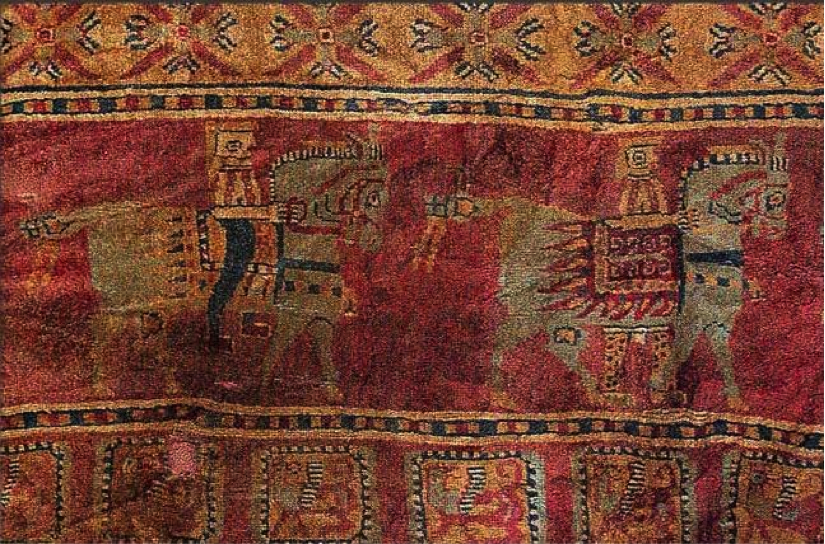The article below by Professor Gerhard Doerfer on the Chagatay Language and Literature was originally posted in the Encyclopedia Iranica on December 15, 1991 and last updated on October 13, 2011.
It is generally acknowledged by scholars that of all the Turkic languages, it was Chaghatay that by far, enjoyed the greatest prestige. Ebn Mohannā, for instance, characterized it as the purest of all Turkish languages, and the khans of the Golden Horde and of the Crimea, as well as the Kazan Tatars, wrote in Chaghatay much of the time. Professor Doerfer has provided a detailed academic overview of the Iranian linguistic influences upon Chagatay in the Encyclopedia Iranica article discussed below.
=========================================================
Development of Chaghatay
Languages from three different Turkic language groups were spoken in Central Asia before the Russian conquest. Chaghatay is the common designation for a language belonging to the Western Uighur, or Eastern Turkic, language group, the easternmost of the three. The other two groups were the Oghuz (including Turkman, Khorasani Azeri and Turkish, and Turkish in Turkey) and the Kipchak (Qipcaq/Qepčāq). Uighur and Kipchak have retained such archaic features as initial t and k, which became voiced d and g in the languages of the Oghuz group. (For general surveys of the distribution of the Turkish languages see Poppe, Menges, Benzing and Menges.)
Western Uighur developed in three stages: Ḵᵛārazm (Choresm) Turkish or Early Chaghatay (7th-8th/13th-14th centuries), Classical and Late Chaghatay (9th-13th/15th-19th centuries), and modern Uzbek (see central asia xiv. turkish-iranian language contact). There are variations in the labels for these stages, however (cf. Eckmann, 1966, pp. 1-10). Soviet scholars (e.g., Shcherbak) refer to both the first two stages as Old Uzbek, whereas most other Western scholars label the first stage “Ḵᵛārazm Turkish.” The term Early Chaghatay, which was introduced by M. F. Köprülü (İA III), will be used here (linguistically, what is labeled “Ḵᵛārazm Turkish” is the direct predecessor of Classical Chaghatay, and it is better to reserve the term for Turkish spoken in Ḵᵛārazm). Comparison of certain forms and words from these three linguistic stages in Central Asia (as in Eckmann, 1957) reveals a sharply declining percentage of words inherited from Old Turkish (8th century): 67.9 percent in the time of the Qarakhanids (or Ilek Khans; 388-607/998-1211), 51.8 percent in Early Chaghatay, but only 14.3 percent in Classical Chaghatay, which may thus also be regarded as an early stage of Uzbek.
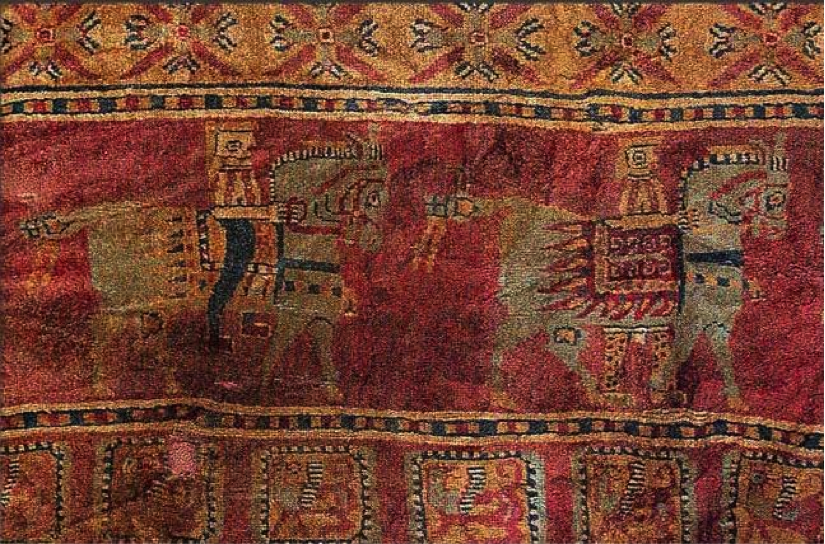 A portion of the Pazyryk carpet found in Central Asia dated to 2,500 years ago. Known as the first known Persian carpet, note the depictions of mythical (winged) lions on the bottom panels. Of interest are the “X” type symbols along the top panels. These were to become a central motif in the major standard of Partho-Sassanian Iran: the Drafsh e Kaviani or the Standard of Kaveh.
A portion of the Pazyryk carpet found in Central Asia dated to 2,500 years ago. Known as the first known Persian carpet, note the depictions of mythical (winged) lions on the bottom panels. Of interest are the “X” type symbols along the top panels. These were to become a central motif in the major standard of Partho-Sassanian Iran: the Drafsh e Kaviani or the Standard of Kaveh.
Of all the Turkic languages Chaghatay enjoyed by far the greatest prestige. Ebn Mohannā (Jamāl-al-Dīn, fl. early 8th/14th century, probably in Khorasan), for instance, characterized it as the purest of all Turkish languages (Doerfer, 1976, p. 243), and the khans of the Golden Horde (Radloff, 1870; Kurat; Bodrogligeti, 1962) and of the Crimea (Kurat), as well as the Kazan Tatars (Akhmetgaleeva; Yusupov), wrote in Chaghatay much of the time. Even Old Ottoman literature is characterized by many attempts, not always successful, to write in Chaghatay, for instance, a decree of Moḥammad II Fāteḥ (Mehmet II Fatih, 855-86/1451-81) dated 878/1473 (Arat), the “Taḵmīs” of Fożūlī (ca. 885-963/1480-1556; Fuzûlî, pp. 462-64), and the works of many lesser authors (Sertkaya, 1970-76). Chaghatay exerted a strong influence on Kipchak and Oghuz, whereas grammatical forms from these two languages occurred more rarely in Chaghatay, being limited mainly to poetry, where they were adopted in order to satisfy the constraints of the ʿarūż meters (e.g., qalmïš-am, long-short-long, instead of qalmïš-man, long-long-long).
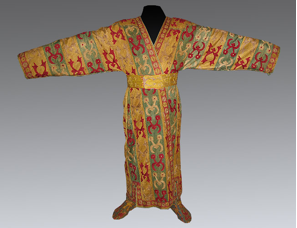 A Suzani Robe from Ancient Bukhara, a mutli-colored style of silk embroidery from Central Asia’s Ferghana valley (Picture Source: Suzanis Blog).
A Suzani Robe from Ancient Bukhara, a mutli-colored style of silk embroidery from Central Asia’s Ferghana valley (Picture Source: Suzanis Blog).
János Eckmann has provided a general survey of the development of oriental Turkish (1957; for more detailed expositions, see Eckmann, 1959a; idem, 1959c; Shcherbak; Brockelmann). The best Chaghatay dictionary has been compiled by Moḥammad Mahdī Khan (d. 1160/1747); the most useful grammars are those by A. M. Shcherbak and Eckmann (1966).
Iranian linguistic influence on Chaghatay
As the cultural centers of the Turks shifted from the northeast to the southwest, Iranian influences increased proportionately. Inscriptions from the 2nd/8th century, when the center of the Old Turkish empire lay in Mongolia, contain only a few Iranian loanwords, particularly titles (Aalto; Rossi). With the blossoming of Uighur culture in Khocho in the 3rd/9th century an increasing number of Sogdian and early Persian words found their way into the Uighur dialect of Old Turkish. When Qarakhanid literature began to develop in southwestern Xinjiang (Kāšḡar and Balāsaḡūn) in the 5th/11th century and at the same time Islam spread through the area, Persian words, including borrowings from Arabic, became more common. In the 8th/14th century Ḵᵛārazm, where the Persian influence was much stronger, became a cultural center. Under the Timurids Herat (capital of Šāhroḵ, r. 807-50/1405-47), Samarkand (capital of Oloḡ Beg, r. 850-53/1447-49), and Shiraz (seat of the prince Eskandar Mīrzā, d. 827/1423-24) were the main literary centers in the first half of the 9th/15th century, and Herat remained so through the reign of Sultan Ḥosayn Bāyqarā (875-912/1470-1506). After the Timurids were succeeded in Transoxania by the Shaibanids in 906/1500 (see central asia v, vi), Bukhara, Samarkand, Ḵᵛārazm, Balḵ (Šaybānīḵān), and Farḡāna became the Chaghatay cultural centers. The Timurid Bābor founded the Mughal dynasty in 932/1526, after which Afghanistan and India also played an important role. With the formation of the Central Asian khanates in the 11th/17th century Chaghatay continued to be written only in Ḵīva and Ḵokand; in Bukhara the written language was generally Persian (cf. Eckmann, 1959b; idem, 1959c).
A number of Persian grammatical features were adopted in Chaghatay, for example, postpositions (e.g., tā “until,” ṭaraf “towards”), conjunctions (e.g., ägär “if,” ki general subordinating conjunction), eżāfa (jism i nātuvānïm “my weak body”), yā-ye ešārat (oq-ī ki yadïn čïqtï “the arrow which flew from the bow”), and yā-ye waḥdat (köprüg-ī gä yätär “he comes to a bridge”; see Brockelmann, pp. 159-60, 186-87, 196-97, 393-427; Kales, pp. 13-15; central asia xv). Beginning in the 9th/15th century a large number of Persian loanwords also came into use.
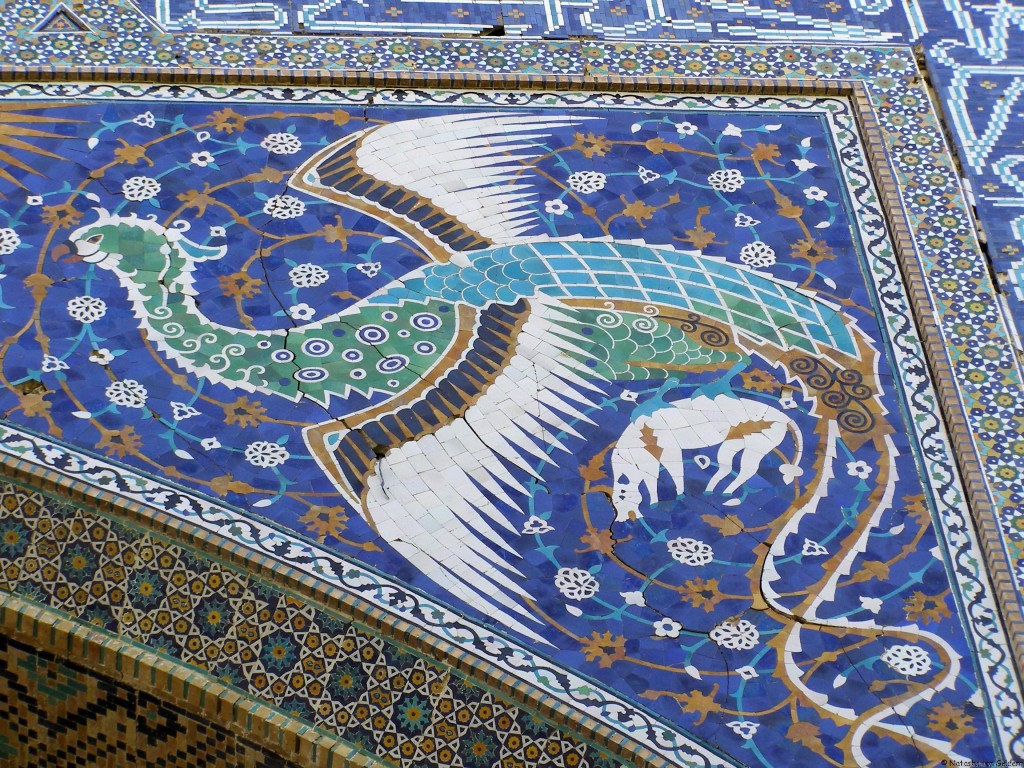 Post-Sassanian style decoration motifs common in Iranian architecture adorn this mosque archway in Bukhara; note large bird or Simurgh (Persian Phoenix – Turkic: Ertugrul), a dog reminiscent of Sassanian arts and the floral-arboreal patterns (Picture source: Natasha von Geldern in World Wandering Kiwi).
Post-Sassanian style decoration motifs common in Iranian architecture adorn this mosque archway in Bukhara; note large bird or Simurgh (Persian Phoenix – Turkic: Ertugrul), a dog reminiscent of Sassanian arts and the floral-arboreal patterns (Picture source: Natasha von Geldern in World Wandering Kiwi).
Even when Chaghatay authors deliberately set out to write in Turkish they were not able to avoid using Persian words. For example, when the vizier and poet ʿAlī- Šīr Navāʾī (844-906/1441-1501), encouraged by Sultan Ḥosayn Bāyqarā, wrote Moḥākamat al-loḡatayn in order to prove the superiority of Turkish over Persian (See Encyclopedia Iranica’s CENTRAL ASIA v. HISTORY UNDER THE MONGOLS AND TIMURIDS), he used a language that contained 62.6 percent Persian and Arabic words (sample: 122 of 195 words).
Throughout history Turkish words have also entered Persian (Doerfer, I, pp. 3-5, 37-44). In the 5th/11th century the primary source was Saljuq Turkish, in the 7th-9th/13th-15th centuries Mongolian and Chaghatay, and beginning in the 10th/16th century Azerbaijani Turkish. The Chaghatay vocabulary in Persian was, however, generally limited to macaronic verses (e.g., Qurašī, beg. 14th cent.: čandān bezī ay šāh ke gūyad tork-ī/yavlaq qarï bolmïš Münmiš tegin “live so long, o king, that a Turk may say: very old has Münmiš tegin become!” where the first part is Persian, the second Early Chaghatay; cf. Doerfer, Elemente I, p. 20); formulas in decrees (e.g., sözümiz “our word”); names of years in the duodecimal animal cycle (See calendar); and terms for hunting and animal husbandry, matters of state and administration, and warfare (e.g., in the work of the historian Mīrḵᵛānd, 836/903/1433-98, another protégé of Sultan Ḥosayn Bāyqarā). Persian literature from Central Asia, on the contrary, contains very few Turkish elements. For instance, Navāʾī’s contemporary, the poet ʿAbd-al-Raḥmān Jāmī (817-98/1414-92), still another protégé of Sultan Ḥosayn, used no Turkish words. (For Turkish influence on the Iranian languages spoken in Central Asia, especially Tajiki Persian, see central asia xv; Doerfer, Elemente; idem, 1967).
Mutual literary influences
The first important monuments of Early Chaghatay literature, from the 8th/14th century (Eckmann, 1964a; Köprülü, İA III, pp. 280-85), all exhibit strong Persian influence. Iranian influence in Central Asian Turkish literature can be traced even farther back, as can perhaps also Turkish influence in Iranian and Persian literature. Analyses of Middle Persian poetry and modern popular literature in various Iranian dialects have revealed structural similarities with Old Turkish literary patterns (Benveniste; Bertel’s, pp. 53, 74-75; Boratav, pp. 112-13; Köprülü, İA I, pp. 637-40; idem, 1986, pp. 137-41; idem, 1934, p. 219; Mann, pp. 32, 36; Massé, Croyances, p. 492; Pagliaro and Bausani, pp. 132, 527-35; Rempis; Rypka, Hist. Iran. Lit., pp. 49-52, 74, 92, 134, 694-97). The structure of Old Turkish poetry can be reconstructed from a comparison of the oldest Turkish literature with modern forms that have not been influenced by Persian poetry (Bang and Gabain; Birtek; Bombaci, 1969, p. 35; Boratav; Dilçin, pp. 39-58; Doerfer, 1964b, pp. 867-70; idem, forthcoming; Gandjeï, 1958b, esp. pp. 144-52; Köprülü, İA, pp. 645-48; idem, 1919, p. 7; Kowalski, esp. pp. 157-64; Radloff, 1870; Stebleva, 1965, pp. 29-37; idem, 1971a; idem, 1971c, pp. 86-87, 296-98; idem, 1971b, pp. 80-81; idem, 1970; idem, 1976; Tekin; Zhirmunskiĭ, 1965; idem, 1970, pp. 40-48, 50-52; Yesevî). Meter depended on the number of syllables (often seven or eight), rather than on stress or quantity; caesuras occurred naturally between identical structures of meaning. The strophe normally consisted of four verses, more rarely two. Rhyme was usually effected through identical grammatical endings, the end of each verse being stressed on the last syllable; suffixes were assonant. The most frequent rhyme schemes were aaab and aaba. Alliteration was only occasionally used, but both parallelism and repetition of words were common.
 These patterns survived in the works of Aḥmad Yasawī (d. 562/1166) and his successors, who wrote in simple language (Bodrogligeti, 1974; Bombaci, 1969, pp. 113-14; Eckmann, 1964b, p. 365; Eraslan, p. 193; Gandjeï, 1958b, pp. 151-53; Köprülü, İA III, pp. 283, 285, 288, 311; idem, İA I, pp. 644-46; idem, 1919, pp. 102,119-21; Kowalski, p. 162; Yesevî). On the other hand, ʿarūż had been adopted by Turkish writers in its Persian form in the 5th/11th century (Köprülü, İA I; idem, 1919, p. 15; idem, 1986, pp. 134-35; Rypka, Hist. Iran. Lit., p. 923). The oldest Turkish example of ʿarūż is to be found in the Qutaḏgū Bilig of Yūsof Ḵāṣṣ Ḥājeb (written 462/1070), a maṯnawī in the motaqāreb meter (Bombaci, 1969, p. 110; Gandjeï, 1958b, pp. 149-50; cf. Yūsof, tr. Dankoff). Contrary to previous assumptions (Köprülü, İA I, pp. 644-46; Stebleva, 1971c, p. 287; idem, 1976, p. 158), Yūsof used it quite correctly (Tekin, 1967). Maḥmūd Kāšḡarī (d. after 476/1094), on the other hand, used the ʿarūż imperfectly, relying on the number of syllables and sometimes resorting to graphic devices (e.g., omitting letters marking long vowels) in order to simulate a perfect ʿarūż (Stebleva, 1971c). This lack of facility in the use of the ʿarūż remained typical of Turkish literature for some time afterward (Bombaci, p. 53; Eckmann, 1964b, p. 134; Gandjeï, 1958b, p. 153; Köprülü, İA III, p. 249; idem, İA I, pp. 645-46; Rustamov, p. 129; Stebleva, 1971c, p. 287; 1976, p. 158; see also Doerfer, forthcoming, b).
These patterns survived in the works of Aḥmad Yasawī (d. 562/1166) and his successors, who wrote in simple language (Bodrogligeti, 1974; Bombaci, 1969, pp. 113-14; Eckmann, 1964b, p. 365; Eraslan, p. 193; Gandjeï, 1958b, pp. 151-53; Köprülü, İA III, pp. 283, 285, 288, 311; idem, İA I, pp. 644-46; idem, 1919, pp. 102,119-21; Kowalski, p. 162; Yesevî). On the other hand, ʿarūż had been adopted by Turkish writers in its Persian form in the 5th/11th century (Köprülü, İA I; idem, 1919, p. 15; idem, 1986, pp. 134-35; Rypka, Hist. Iran. Lit., p. 923). The oldest Turkish example of ʿarūż is to be found in the Qutaḏgū Bilig of Yūsof Ḵāṣṣ Ḥājeb (written 462/1070), a maṯnawī in the motaqāreb meter (Bombaci, 1969, p. 110; Gandjeï, 1958b, pp. 149-50; cf. Yūsof, tr. Dankoff). Contrary to previous assumptions (Köprülü, İA I, pp. 644-46; Stebleva, 1971c, p. 287; idem, 1976, p. 158), Yūsof used it quite correctly (Tekin, 1967). Maḥmūd Kāšḡarī (d. after 476/1094), on the other hand, used the ʿarūż imperfectly, relying on the number of syllables and sometimes resorting to graphic devices (e.g., omitting letters marking long vowels) in order to simulate a perfect ʿarūż (Stebleva, 1971c). This lack of facility in the use of the ʿarūż remained typical of Turkish literature for some time afterward (Bombaci, p. 53; Eckmann, 1964b, p. 134; Gandjeï, 1958b, p. 153; Köprülü, İA III, p. 249; idem, İA I, pp. 645-46; Rustamov, p. 129; Stebleva, 1971c, p. 287; 1976, p. 158; see also Doerfer, forthcoming, b).
The question of the origin of the robāʿī (quatrain), which was popular in both Iranian and Turkish literatures, is controversial. E. E. Bertel’s (p. 88), Tadeusz Kowalski (pp. 161-63), and L. Z. Rustamov (pp. 77-81) suggested that in Iranian literature it was borrowed from Turkish folk literature. On the other hand, Alessio Bombaci (p. 54), Köprülü (İA I, p. 646; 1919, p. 15), and I. V. Stebleva (1970, pp. 137-38) have argued that in Turkish literature it was a borrowing from Iranian. Paul Horn (apud Kowalski, p. 37), Gerhard Doerfer (1964a, pp. 839-40), and V. M. Zhirmunskiĭ (1970, p. 39) have taken the view that the Iranian and Turkish forms developed independently. Finally, Köprülü (1934, pp. 115-22) argued formerly that the similarities resulted from mutual influence in ancient times. The four-line strophe has a long history in Turkish literature (Köprülü, 1919, p. 7; 1986, pp. 137-41; 1934, p. 113; Stebleva, 1970, p. 147), the earliest known examples being from Turkish songs partially quoted by the poets Abu’l-Najm Aḥmad b. Qūs Manūčehrī (d. 432/1041), Badr-al-Dīn Qawwāmī Razī (d. ca. 560/1165), and Jamāl Qurašī (fl. 7th/13th century), and a robāʿī composed by Faḵr-al-Dīn Mobārakšāh in 602/1206 (Köprülü, 1934, pp. 28-32, 113-22). In Persian literature, on the other hand, it took a highly original form (Bertel’s, p. 88).
During the period 710-70 (1310-1369 a series of poetic, juridical, linguistic, and religious works, including translations of the Koran, were written in Chaghatay. Most were based to some degree on older works, for instance, Qoṭb’s Ḵosrow o Šīrīn (written ca. 742/1341; ed. Hacieminoğlu; idem, ed. Zajączkowski), composed after Neẓāmī’s work under the rule of the Golden Horde, and an anonymous translation of Taḏkerat al-awlīāʾ by Farīd-al-Dīn ʿAṭṭār (Eckmann, 1964a; Köprülü, in İA III, pp. 280-85). In the first half of the 9th/15th century there were also several less distinguished writers like ʿAṭāʾī, Sakkākī, and Loṭfī (Rustamov; cf. Eckmann, 1964b, pp. 306-26; Köprülü, in İA III, pp. 290-94). The apogee of Chaghatay literature was reached during the reign of the Timurid sultan Ḥosayn Bāyqarā, in the work of Mīr ʿAlī-Šīr Navāʾī, whose style remained a model for the ensuing period (Bombaci, 1969, pp. 130-83, esp. 145-63; Eckmann, 1964b, pp. 329-57; Köprülü, 1934, pp. 257-66; idem, in İA III, pp. 289-302; Navāʾī, ed. Alpay; idem, ed. Devereux; idem, ed. Dmitrieva; Levend). Persian influence was also strong at that time. Particularly admired were the poets Ferdowsī (d. 411/1020), Neẓāmī Ganjavī (d. 599/1203), Saʿdī (691/1292), Ḥāfeẓ (d. ca. 792/1390), Amīr(-e) Ḵosrow Dehlavī (q.v.; d. 725/1325), Salmān Sāvajī (d. 778/1376), and Jāmī. Bilingualism must have been widespread among Islamic peoples in Central Asia (Pagliaro and Bausani, p. 752), for many Turkish-speaking Chaghatay poets composed works in Persian (Bombaci, 1964, p. xxvii; Eckmann, 1964a; idem, 1964b; Köprülü, 1919, pp. 113-22; Rypka, Hist. Iran. Lit., p. 500; Togan, p. 231). In Persia itself there was a nucleus of Chaghatay writers in Shiraz, and Chaghatay was also written in Qazvīn and Isfahan (Eckmann, 1964a, pp. 295-96; idem, 1964b, p. 326; Gandjeï, 1971a; idem, 1971b; Köprülü, in İA III, pp. 278, 305). In India Bābor wrote in Chaghatay (Köprülü, in İA III, pp. 314-316). Translation of Persian works into Chaghatay was common, for instance, Navāʾī’s translation of works by Jāmī (Eckmann, 1964a, pp. 293-96; idem, 1964b, pp. 309, 366-69; Köprülü, in İA II, pp. 296, 301, 321), while, in comparison, translations of Chaghatay works into Persian were rare. The earliest are of relatively late date, from the reign of Tīmūr (771-804/1370-1405); among later translations note, for instance, that by Faḵrī Herātī and Ḥakīm Šāh Moḥammad Qazvīnī’s of Navāʾī’s Majāles al-nafāʾes in the 10th/16th century (Eckmann, 1964b, pp. 355, 370, 374-75; Gandjeï, 1969; Köprülü, in İA III, pp. 279, 316; Rustamov, pp. 85, 131-32; Rypka, Hist. Iran. Lit., pp. 634-39); some earlier Persian authors did, however, effect Turkish terms (Gandjeï, 1958b; Minorsky; Pagliaro and Bausani, pp. 480-81). Turkish poets of the 9th/15th century used meters based on ʿarūż, especially in the important tuyuḡ (quatrain), for which the meter ramal-e mosaddas-e maqṣūr (long short long long/long short long long/long short long) and the rhyme scheme aaba (as in the robāʿī) were used; an important example is Navāʾī’s Mīzān al-awzān (Eckmann, 1964b; Köprülü, in İA III, p. 292; idem, in İA I, pp. 647-49; Köprülü, 1919, pp. 204-56; Navāʾī, ed. Devereux, pp. 14-15; Pagliaro and Bausani, p. 534; Rustamov, pp. 75-81; Stebleva, 1970). Under the Shaibanids (832-1007/1429-1598) Chaghatay became the predominant literary language of Transoxania and was used by some of the great khans themselves (Šībānī Khan and ʿObayd-Allāh Khan [see central asia vi] both left dīvāns; cf. Eckmann, 19646, p. 361; Köprülü, in İA III, p. 318), except in the khanate of Bukhara, where it gradually disappeared (Eckmann, 1964b, p. 387). The Chaghatay literature of the 11th-14th/17th-20th centuries seems largely epigonic; so far, however, little research has been done on this literature (cf. Eckmann, 1964b, pp. 377-402; Ḵāleṣ). Bibliography P. Aalto, “Iranian Contacts of the Turks in Pre-Islamic times,” in Studia Turcica, ed. L. Ligeti, Budapest, 1971, pp. 29-37. Y. S. Akhmetgaleeva, Issledovanie tyurkoyazychnogo pamyatnika “Kisekbash kitaby”, Moscow, 1979. R. R. Arat, “Fatih Sultan Mehmed’in yarlığı,” Türkiyat mecmuası 6, 1939, pp. 285-322. R. Arzibekov, “O genezise i tipologii rubai,” Sovetskaya tyurkologia 5, 1985, pp. 25-33. B. Malay, Abuşka lûgatı veya Çagatay sözlüğü, Ankara, 1970. Ẓahīr-al-Dīn Moḥammad Bābor, Traktat ob ʿarūze, ed. I. V. Stebleva, Moscow, 1972. W. Bang-Kaup and A. von Gabain, “Türkische Turfan-Texte II. Manichaica,” SPAW, 1929, no. 22, pp. 411-30. E. Benveniste, “Le texte du Draxt Asūrīk,” JA 217, 1930, pp. 193-225. J. Benzing, Einführung in das Studium der altäischen Philologie und der Turkologie, Wiesbaden, 1953. Idem and K. H. Menges, “Classification of the Turkic Languages,” in Philologiae Turcicae Fundamenta I, Wiesbaden, 1959, pp. 1-10. E. E. Bertel’s, Istoriya persidsko-tadzhikskoĭ literatury, Moscow, 1960. F. Birtek, En eski Türk savları, Ankara, 1944. A. Bodrogligeti, “A Turkish Folk Song from the Golden Horde,” Acta Orientalia Hungarica 15, 1962, pp. 23-30. Idem, “Aḥmad’s Baraq-nāma. A Central Asian Islamic Work in Eastern Middle Turkic,” Central Asian Journal 18, 1974, pp. 83-128. Idem, “The Authorship and Sources of the Muʿīnu’l-murīd,” in W. Heissig et al., eds., Tractata Altaica, Wiesbaden, 1976, pp. 87-105. A. Bombaci, “The Turkic Literatures . . . ,” in Philologiae Turcicae Fundamenta II, Wiesbaden, 1964, pp. xi-lxxii. Idem, La literatura turca, Milan, 1969. P. N. Boratav, “La poésie folklorique,” in Philologiae Turcicae Fundamenta II, Wiesbaden, 1964, pp. 90-128. A. K. Borovkov, Leksika sredneaziatskogo tefsira XII-XIII vv., Moscow, 1963 (Mongol loanwards reflecting, rather, 8th/14th-century usage). C. Brockelmann, Osttürkische Grammatik der islamischen Litteratursprachen Mittelasiens, Leiden, 1954. S. Ş. Čağatay, Turk Iehçeleri örnekleri, Ankara, 1963. R. Dankoff, The Turkic Vocabulary in the Farhang-i Zafân-Gûyâ(8th/14th Century), Bloomington, Ind., 1987. A. Dilâçar, Türk diline genel bir bakış, Ankara, 1964. C. Dilçin, Örneklerle Türk şiir bilgisi, Ankara, 1983. G. Doerfer, “Die gagausische Literatur,” in Philologiae Turcicae Fundamenta II, Wiesbaden, 1964a, pp. 835-40. Idem, “Die Literatur der Türken Südsibiriens,” in Philologiae Turcicae Fundamenta II, Wiesbaden, 1964b, pp. 862-85. Idem, Türkische Lehnwörter im Tadschikischen, Wiesbaden, 1967. Idem, “Woher stammte Ibn Muhannā?” AMI 9, 1976, pp. 243-51. Idem, “Zum altaischen Stabreim” (forthcoming, a). Idem, Formen der türkischen Lyrik (forthcoming, b). J. Eckmann, “Zur Charakteristik der islamischen mittelasiatisch-türkischen Literatursprache,” in Studia Altaica. Festschrift für Nikolaus Poppe, Wiesbaden, 1957, pp. 51-59. Idem, “Das Chwarezmtürkische,” in Philologiae Turcicae Fundamenta I, Wiesbaden, 1959a, pp. 113-37. Idem, “Eine ostmitteltürkische interlineare Koranübersetzung,” Ural-altaische Jahrbücher 31, 1959b, pp. 72-85. Idem, “Das Tschaghataische,” Philologiae Turcicae Fundamenta I, Wiesbaden, 1959c, pp. 138-60. Idem, “Die kiptschakische Literatur I. Die Literatur von Chwarezm und der Goldenen Horde,” in Philologiae Turcicae Fundamenta II, Wiesbaden, 1964a, pp. 275-96 (not in fact Qipchaq literature). Idem, “Die tschaghataische Literatur,” in Philologiae Turcicae Fundamenta II, Wiesbaden, 1964b, pp. 304-402. Idem, Chagatay Manual, Indiana University Publications 60, Bloomington, Ind., 1966. Idem, “Eastern Turkic Translations of the Koran,” in Studia Turcica, ed. L. Ligeti, Budapest, 1971, pp. 149-59. K. Eraslan, “Azîm Hâce’nin hikmetleri,” Türk dill ve edebiyatı dergisi 19, 1971, pp. 193-230. E. I. Fazylov, Starouzbekskiĭ yazyk, 2 vols., Tashkent, 1966-71. Fuzûlî (Fożūlī), Türkçe divan, ed. K. Akyüz et al., Ankara, 1958. Gadāʾī, The Dīvān of Gadā’ī, ed. J. Eckmann, Bloomington, Ind., 1971. T. Gandjeï, “Über die türkischen und mongolischen Elemente der persischen Dichtung der Ilchan-Zeit,” in Ural-altaische Jahrbücher 30, 1958a, pp. 229-31. Idem, “Überblick über den vor- and frühislamischen türkischen Versbau,” Der Islam 33, 1958b, pp. 142-56. Idem, “Navā’ī’s Poem in the Persian Verse Translation of Sa’īd,” in Central Asiatic Journal 13, 1969, pp. 146-51. Idem, “The “Laṭāfat-nāma” of Khujandi,” AIUON 30, 1970, pp. 345-68. Idem, “Kazvinli Vâ’iz’in Türkçe şiirleri,” Türk dili ve edebiyatı dergisi 19, 1971a, pp. 185-92. Idem, “Sâdikî-i Afşar’ın türkçe şiirleri,” Türkiyat mecmuası 16, 1971b, pp. 19-26. H. F. Hofman, Turkish Literature. A Bio-Bibliographical Survey III/1, 2 vols., Utrecht, 1969. Nūr-al-Dīn ʿAbd-al-Raḥmān Jāmī, Laylī wa Majnūn, ed. A. Khan Afṣaḥzād, Moscow, 1972. Yaʿqūb Ḵᵛāja Ḵāleṣ, Ḫāliṣ’s Story of Ibrāhīm, ed. A. J. E. Bodrogligeti, Leiden, 1975. Ḵojandī (Khodzhandi), Latafat-name, ed. E. I. Fazylov, Tashkent, 1976. A. N. Kononov, Rodoslovnaya turkmen, sochinenie Abu-l-Gazi khana khivinskogo, Moscow and Leningrad, 1958. M. F. Köprülü (Köprülüzade), Türk edebiyatında ilk mutasavvıflar, Istanbul, 1919; repr. Istanbul, 1966. Idem, Türk dili ve edebiyatı hakkında araştırmalar, Istanbul, 1934. Idem, “Aruz,” in İA I, pp. 625-53. Idem, “Çagatay edebiyatı,” in İA III, pp. 270-323. Idem, “La métrique ʿarūż dans la poésie turque,” in Philologiae Turcicae Fundamenta II, 1964, pp. 625-53. Idem, Türk edebiyatı tarihi, Istanbul, 1986, esp. pp. 275-327. T. Kowalski, Ze studjów nad formą poezii ludów tureckich, Cracow, 1921. A. N. Kurat, Topkapı Sarayı müzesi aṛşivindeki Altın Ordu Kırım ve Türkistan hanlarına ait yarlık ve bitikler, Istanbul, 1940. A. S. Levend, Ali Şir Nevaî. Hayatı, sanatı ve kişiliği . . . , 4 vols., Ankara, 1965-68. R. Loewenthal, The Turkic Languages and Literatures of Central Asia, The Hague, 1957. M. Lüthi, Märchen, Stuttgart, 1974. Moḥammad Mahdī Khan, Sanglax. A Persian Guide to the Turkish Language by Muhammad Mahdī Xān, ed. G. Clauson, London, 1960. O. Mann, Die Mundarten der Lur-Stämme im südwestlichen Persien, Berlin, 1910. K. H. Menges, The Turkic Languages and Peoples, Wiesbaden, 1968. V. Minorsky, “Pūr-i Bahā’s “Mongol” Ode,” BSOAS 18, 1956, pp. 261-78. E. N. Nadzhip, Istoriko-sravnitel’nyĭ slovar’ tyurkskikh yazykov XIV veka na materialakh “Ḵosrau i Šīrīn” Kutba I, Moscow, 1979. Mīr ʿAlī-Šīr Navāʾī, Dīvān, ed. L. V. Dmitrieva, Moscow, 1964. Idem, Moḥākamat al-loḡatayn, ed. R. Devereux, Leiden, 1966. Idem, Ferhad ü Şirin, ed. G. Alpay, Ankara, 1975. Nehcü’l-ferādīs (probably by Maḥmūd b. ʿAlī), ed. J. Eckmann, S. Tezcan, and H. Zülfikar, Ankara, 1984. A. Pagliaro and A. Bausani, Storia della letteratura persiana, Milan, 1960. Qoṭb, Kutb’un Husrev ü Şirin’i ve dil hususiyetleri, ed. N. Hacieminoğlu, Istanbul, 1968. Idem, Najstarsza wersja turecka Ḫusräv u Šīrīn Quṭba, ed. A. Zajączkowski, 3 vols., Warsaw, 1958-61. N. Poppe, Introduction to Altaic Linguistics, Wiesbaden, 1965. W. Radloff (V. V. Radlov), Proben der Volksliteratur der türkischen Stämme Süd-Sibiriens III. Kirgisische Mundarten, St. Petersburg, 1870. Idem, “Yarlyki Toktamysha i Temir-Kutluga,” Zapiski Vostochnago otdeleniya russkago arkheologicheskago obshchestva 3, 1888, pp. 1-40. C. Rempis, “Die ältesten Dichtungen im Neupersischen,” ZDMG 101, 1951, pp. 220-40. A. V. Rossi, “In margine a On the Ancient Turkish Title “Ša’”,” in A. Gallotta and U. Marazzi, eds., Studia Turcologica Memoriae Alexii Bombaci Dicata, Naples, 1982, pp. 407-50. E. R. Rustamov, Uzbekskaya poèziya v pervoĭ polovine XV veka, Moscow, 1963. M. Ṣāleḥ (?), Tawārīḵ-e gozīda—Noṣrat-nāma, ed. A. M. Akramov, Tashkent, 1967. M.-R. Séguy, Le voyage miraculeux du prophète, Montrouge, France, 1977. O. F. Sertkaya, “Osmanlı şâirlerinin Çağatayca şiirleri 1,” Türk dili ve edebiyatı dergisi 18, 1970, pp. 133-8; 19, 1971, pp. 171-84; 20, 1972a, pp. 157-64; 22, 1974-76, pp. 169-89. Idem, “Horezmî’nin Muhabbat-nâme’sinin iki yeni yazma nüshasi üzerine,” Türkiyat mecmuası 17, 1972b, pp. 185-207. A. M. Shcherbak, Grammatika starouzbekskogo yazyka, Moscow and Leningrad, 1962. D. Sinor, Introduction à l’étude de l’Eurasie centrale, Wiesbaden, 1963. I. V. Stebleva, Poeziya tyurkov VI-VIII vekov, Moscow, 1965. Idem, “K voprosu o proiskhozhdenii zhanra tuyug,” Tyurkologicheskiĭ sbornik, 1970, pp. 135-47. Idem, “De quelques particularités du vers turc,” Turcica 3, 1971a, pp. 117-27. Idem, “Proiskhozhdenie i razvitie tyurkskoĭ alliteratsiënnoĭ sistemy v svyazi s istoricheskim rodstvom tyurkskikh i mongol’skikh yazykov,” Sovetskaya Tyurkologiya 6, 1971b, pp. 80-84. Idem, Razvitie tyurkskikh poèticheskikh form v XI veke, Moscow, 1971c. Idem, Poètika drevnetyurkskoĭ literatury i eë transformatsiya v ranne-klassicheskiĭ period, Moscow, 1976. Idem, Semantika gazeleĭ Babura, Moscow, 1982 (contains Bābor’s dīvān as an appendix). Īmānī Ṭāleʿ, Badāʾeʿ al-loḡat, ed. A. K. Borovkov, “Badāʾiʿ al-lugat.” Slovar’ Ṭāliʿ Īmānī Geratskogo k sochineniyam Alishera Navoi, Moscow, 1961. Ş. Tekin, “Uygur edebiyatının meseleleri,” in Türk kültürü araştırmaları II, Ankara, 1965, pp. 26-67. T. Tekin, “Determination of Middle-Turkic Long Vowels through ʿarūḍ,” Acta Orientalia Hungarica 20, 1967, pp. 151-70. Z. V. Togan, “Zentralasiatische türkische Literaturen II. Die islamische Zeit,” in HO I/5, I, Leiden and Cologne, 1963, pp. 229-49. Yesevî (Aḥmad Yasawī), Dîvân-ı Hikmetten seçmeler, ed. K. Eraslan, Ankara, 1983. Yūsof Khāṣṣ Ḥājeb, Kutadgu Bilig I, ed. R. R. Arat, Istanbul, 1947; tr. R. Dankoff as Wisdom of Royal Glory (Kutadgu Bilig), Chicago, 1983. G. V. Yusupov, Vvedenie v bulgaro-tatarskuyu èpigrafiku, Moscow and Leningrad, 1960. V. M. Zhirmunskiĭ (V. Schirmunski), “Syntaktischer Parallelismus and rhythmische Bindung im alttürkischen epischen Vers,” in A. V. Isačğenko et al., eds., Beiträge zur Sprachwissenschaft, Volkskunde and Literaturforschung W. Steinitz zum 60. Geburtstag am 28. Februar 1965 dargebracht, Deutsche Akademie der Wissenschaften zu Berlin. Veröffentlichungen der Sprachwissenschaftlichen Kommission 5, Berlin, 1965, pp. 387-401. Idem, “O nekotorykh problemakh teorii tyurkskogo narodnogo stikha,” Tyurkologicheskiĭ sbornik, 1970, pp. 29-68. 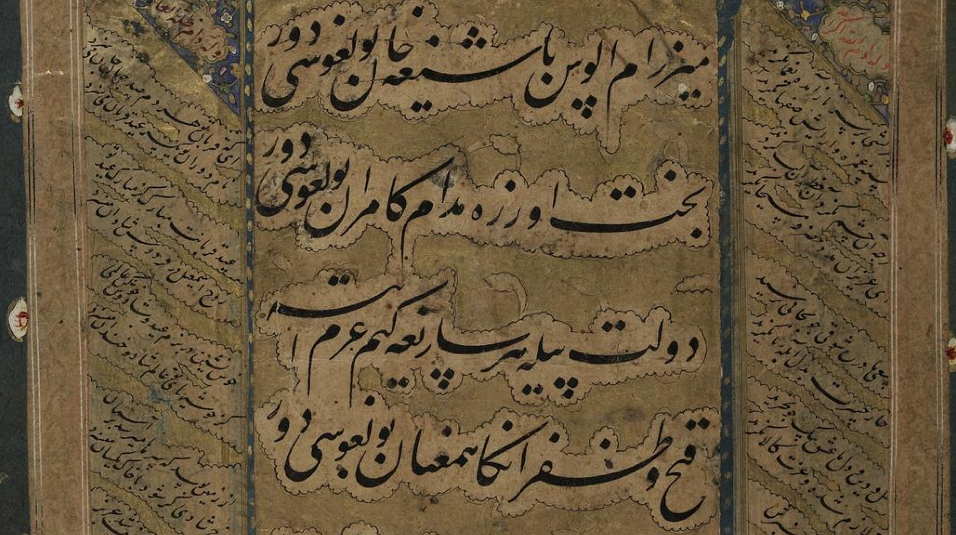
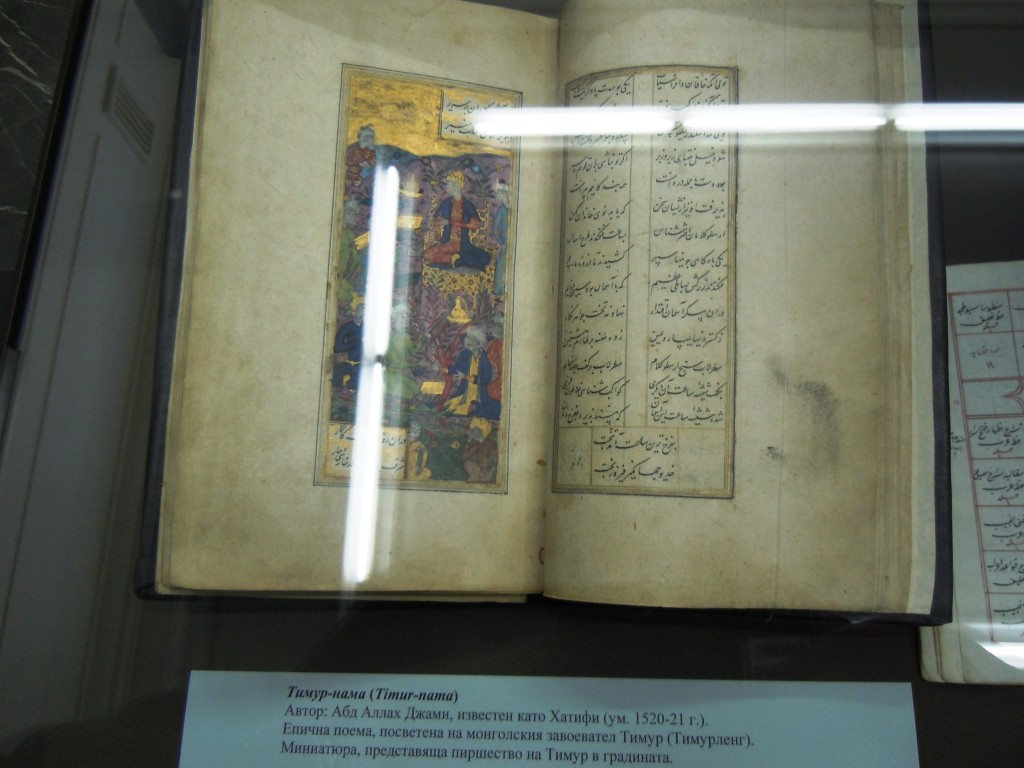 [Click to Enlarge] Timur Nameh (Courtesy of Professor Yuri Stoyanov). On 10 January 2013 the Bulgarian National Library Sts. Cyril and Methodius in Sofia opened an exhibition of Persian manuscripts, early printed books and archival documents to mark the 115th anniversary of the establishment of official diplomatic relations between Bulgaria and Iran. The exhibition presented some of the most valuable documents related to the history of Iran in the collections of the National Library and aims to attract the attention of scholars, researchers and anyone interested in Iranian culture and history. The exhibition is part of the programme “Days of Iranian Culture in Bulgaria – 2012/2013” coordinated by the National Library, the Cultural Representative Office at the Embassy of the Islamic Republic of Iran in Sofia and other institutions. Note that the event was also organized with the help of prominent Iranologist Professor Yuri Stoyanov (member of the Department of the Near and Middle East, Faculty of Languages and Cultures in the School of Oriental and African Studies (SOAS) in the University of London).
[Click to Enlarge] Timur Nameh (Courtesy of Professor Yuri Stoyanov). On 10 January 2013 the Bulgarian National Library Sts. Cyril and Methodius in Sofia opened an exhibition of Persian manuscripts, early printed books and archival documents to mark the 115th anniversary of the establishment of official diplomatic relations between Bulgaria and Iran. The exhibition presented some of the most valuable documents related to the history of Iran in the collections of the National Library and aims to attract the attention of scholars, researchers and anyone interested in Iranian culture and history. The exhibition is part of the programme “Days of Iranian Culture in Bulgaria – 2012/2013” coordinated by the National Library, the Cultural Representative Office at the Embassy of the Islamic Republic of Iran in Sofia and other institutions. Note that the event was also organized with the help of prominent Iranologist Professor Yuri Stoyanov (member of the Department of the Near and Middle East, Faculty of Languages and Cultures in the School of Oriental and African Studies (SOAS) in the University of London).

